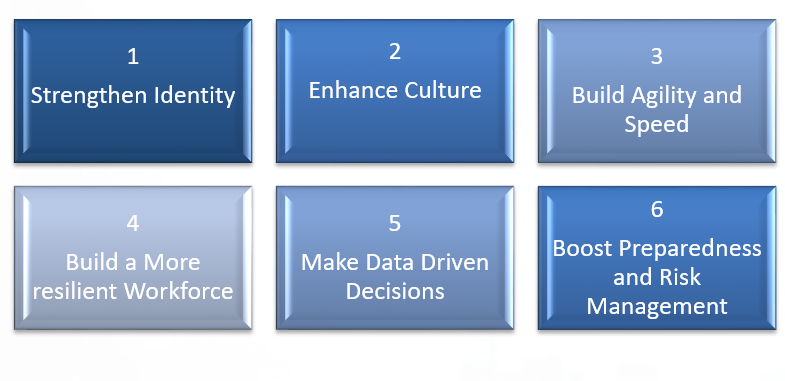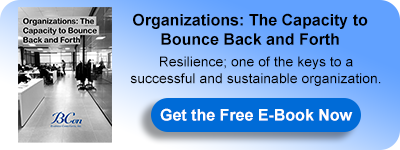Building a Resilience Strategy for the Future
After surviving the beginning of the pandemic in 2020, followed by 2021, it is clear that resilience is a strategy in the first quarter of the year 2022. It will help us survive change and see it as a larger opportunity and reexamine the organization's identity, how it works, and how it grows.
Organizational resilience is a strategic priority that has reached the status of an enterprise-wide aim. Leaders of organizations must commit to a long-term focus on organizational resilience. It's essential to plan when it comes to building resilience.
According to the research, future-ready businesses have three characteristics: they know who they are and what they stand for; they operate with a focus on speed and simplicity; and they grow by expanding their ability to learn, create, and pursue good ideas regardless of origin. Companies will have a better chance of thriving in the new normal if they embrace these foundations.
What's the bad news? There is no time to waste for businesses. In an increasingly winner-take-all corporate environment, where McKinsey’s study reveals that the top 20% of companies earn up to 95% of economic profit, any company that isn't looking for innovative ideas is living on borrowed time.

Strategic Objective One: Strengthening Identity
People desire to belong, and they want to be part of something bigger than themselves. organizations that establish a strong identity that fits the demands of employees for affiliation, social cohesiveness, purpose, and meaning will be more resilient.
Take a deliberate stance. Purpose motivates people to join, stay, and develop in an organization. According to McKinsey’s research, people who think they are "living their Purpose" at work are four times more likely to report higher levels of engagement than those who say they aren't.
Purpose, when placed at the center of work, aids individuals in navigating uncertainty, encourages devotion and even reveals untapped market possibilities.
They are aware of who they are and what they represent. The organization's vision, purpose, and basic principles are well-understood, and all decisions are made with coherence and clarity.
Boost the effectiveness of the organization’s value agenda. Describe how value is created, what sets the organization unique from the competition, and what might propel its future success. Understanding the context and relationships of the organization allows it to make more effective strategic decisions concerning resilience priorities.
Strategic Objective Two: Enhance Culture
Use culture as your "secret sauce," as McKinsey suggests. Its major components are specific and observable actions that employees at all levels follow. The culture of an organization gives its employees a sense of belonging. It instills a sense of dedication and reinforces the organization's ideals.
Engage employees at every level use organizational culture to help develop and maintain trust. Accept change, and the organization will become more flexible and adaptable.
Encourage learning, innovation, and creativity. Rather than blaming and/or emphasizing error reporting. Encourage employees to communicate their thoughts vertically and horizontally throughout the organization. Knowledge is widely exchanged, and it is encouraged to learn from others.
More resilient businesses indicate a commitment to a healthy culture in which common beliefs, values, good attitudes, and behavior are valued and practiced. A healthy organizational culture acts as a behavioral control mechanism.
Leadership behavior is anchored in an organization's awareness of itself and its relationships with others and is a critical contributor to how it implements its organizational resilience strategic objectives. Leaders who constantly model the company's behaviors strive to work practices that stand out and feel new to outsiders. Inventive responses to key moments—everything from employee onboarding to meeting management—are all telltale markers of a strong performance culture. For example, Amazon notably follows the "two-pizza rule," which states that no team should be larger than two pizzas can feed. The guideline supports the company's unconventional approach to meetings: keep them short, avoid PowerPoint, and begin quietly to allow participants time to digest the compulsory premeeting note (dubbed "study hall" by CEO Jeff Bezos).
Strategic Objective Three: Build for Agility and Speed
Operating models must be quick, nimble, and frictionless to support agility and simplicity in the workplace. They must enable a network of empowered, dynamic teams to find value in unexpected places, such as at the organization's "edges," where employees are closest to customers.
High-performance structure and change management adopt models that are centered on people and activities and are built, fostered, and grown around them. As much as feasible, create a flat organization structure. Create a work environment that is both adaptable and productive. Create a network of local cross-functional teams with defined roles and responsibilities. Ensure that everyone understands how work is done, including the connections between work, location, and workers.
If an organization wants to grow consistently, it must be prepared to adjust quickly and frequently. Interacting with stakeholders, technology, and personnel regularly is required. Take advantage of a thriving ecosystem of partners outside of the organization's traditional boundaries.
More resilient firms demonstrate a commitment to managing change by implementing an agile change management strategy that involves all employees.
Strategic Objective Four: Make Your Workforce More Resilient
When information is broadly shared, employed, and recognized as a crucial resource, organizational resilience improves. Treat talent as if it were more valuable than money, cultivating and maintaining it wherever possible.
Talent should be nurtured and retained. Choose and develop leaders with a wide range of qualities, knowledge, and experience. Encourage employees to have positive experiences. Increase engagement by rewarding and recognizing performance. In addition, develop and implement wellness and mentoring initiatives.
Organizational learning should be accelerated. Encourage and enable people to adapt and reinvent themselves to suit changing demands by encouraging and supporting a mindset of continual learning. To support effective decision-making, share knowledge and information promptly. More resilient firms show a commitment to their employees by ensuring that they are engaged, capable of handling stress, making decisions, and managing constant change.
Strategic Objective Five: Make Data-Driven Decisions
Data is the business. Data should be used to support decisions and the organization’s value agenda indefinitely. To stay adaptable, organizations should employ predictive analytics and performance management.
Build data-rich systems for managing change. Create systems that can foresee, plan for, and respond to changing conditions. Use IT operations data to get insights, find patterns, and plan capacity.
Transform your finance management to be more agile. The finance department is the go-to source for decision support, giving analytic knowledge to drive strategy and provide real-time insight into the status of the organization.
Data is used to inform all choices, forecasting, and change management in more resilient businesses. Data-driven enterprises automate operations to boost agility and flexibility.
Strategic Objective Six: Boost Your Preparedness and Risk Management
Uses systems to predict, plan for, and respond to changing conditions. Once available, assigned, and competent resources are all present, an organization can develop and allocate resources like people, premises, procedures, technology, financing, and information to manage vulnerabilities, adapting to changing conditions.
Risk needs to be managed effectively and efficiently. Threats and opportunities coming from sudden or gradual changes in the organization's internal and external surroundings are anticipated and responded to.
When a company controls risk and prepares for the unexpected, it improves its organizational resilience.
1 LBL Strategies, 12 Aug 2021, Lyynda Nelson, Resilience is More Than a Plan – It is a Strategy, Accessed 8 Mar 2022, https://www.lblstrategies.com/organizational-resilience-strategy/
Mckinsey, 11 Jan 2021, Aaron De Smet, Chris Gagnon, and Elizabeth Mygatt, Organizing for the future: Nine keys to becoming a future-ready company, Accessed 8 Mar 2022, https://www.mckinsey.com/business-functions/people-and-organizational-performance/our-insights/organizing-for-the-future-nine-keys-to-becoming-a-future-ready-company
For more about this topic, download our latest book " Organizations: The Capacity to Bounce Back and Forth" for FREE:
